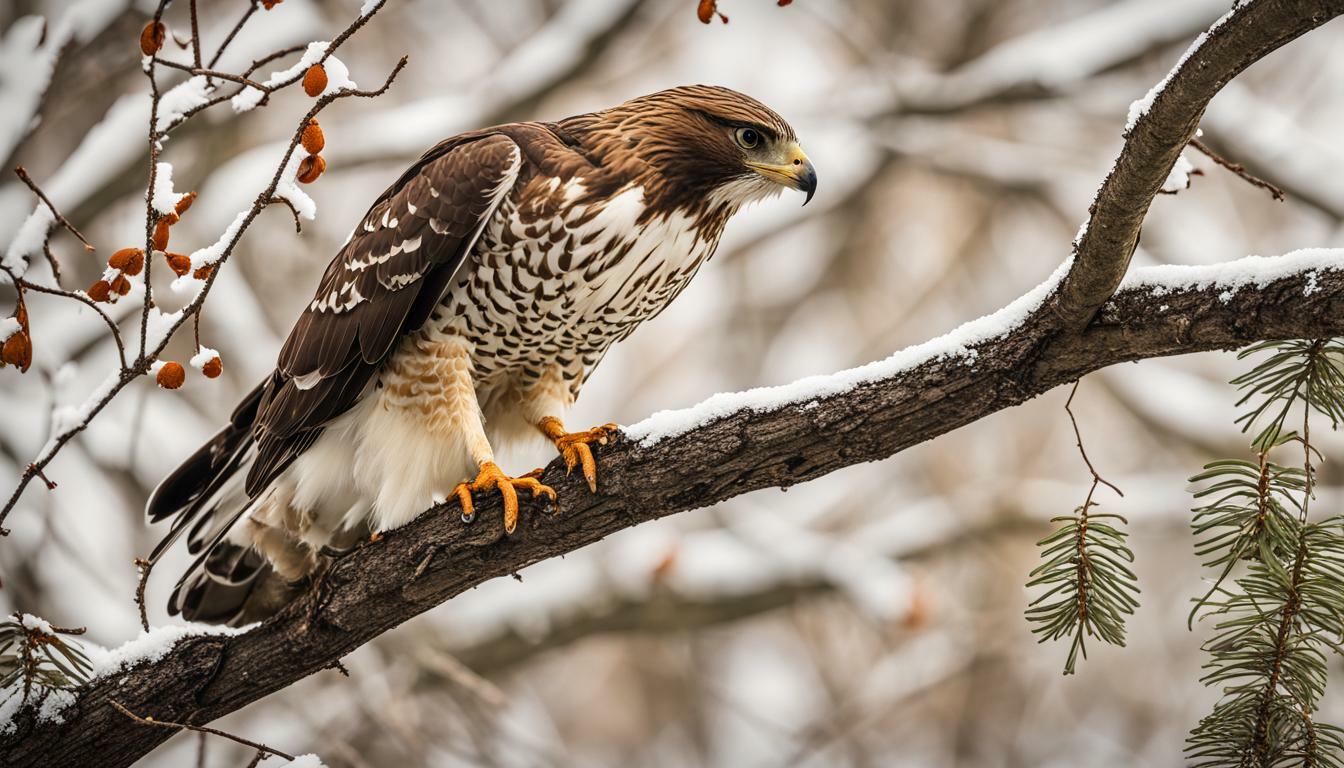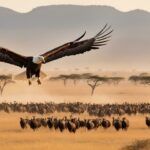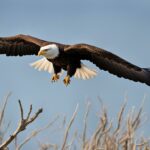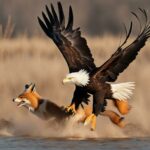If you’re curious about hawks’ dietary habits, you may have wondered whether or not they consume birds. Hawks are known for their predatory behavior and are often seen swooping down from the sky to catch their prey. In this section, we’ll take a closer look at hawks and their diet to explore whether or not they eat birds.
Hawks are formidable predators that have evolved to be efficient hunters. Their diet mainly consists of small animals, including squirrels, rabbits, rodents, reptiles, and amphibians. However, they are also known to consume birds as part of their diet.
In the following paragraphs, we will explore the subject of hawk predation and the consumption of birds in more detail.
Key Takeaways
- Hawks are predators known for their predatory behavior
- Hawks’ diet mainly consists of small animals
- Hawks also consume birds as part of their diet
Understanding Hawk Predation
When it comes to feeding habits, hawks are known for being bird predators. Their prey-preference depends on various factors such as geographical location, habitat, and seasonal availability of prey. In general, hawks prefer birds as their primary source of food.
The diet of hawks varies depending on their species. Some species of hawks prefer small birds such as sparrows and finches, while others may hunt larger birds such as ducks and pheasants. The size of the hawk and its hunting abilities also play a crucial role in determining the type of bird preyed upon.
Hawks are skilled hunters and have various techniques to capture their avian prey. They often ambush their prey from above using their sharp talons to grab the bird mid-air or on the ground. They also use their powerful beaks to strike and kill birds.
Hawk Feeding Habits
Hawks hunt during the day and are diurnal birds of prey. They have keen eyesight and can spot potential prey from a great distance. They also have a high level of intelligence, which allows them to strategize and adapt their hunting techniques to suit their environment.
Hawks use their aerial abilities to their advantage when hunting. They can fly at high speeds and sudden turns, making it difficult for the birds to escape their grasp. Additionally, hawks have extremely sharp talons, which can easily penetrate the flesh of their prey.
Prey-Preference of Hawks
While hawks prey on a variety of animals, including rodents, reptiles, and insects, birds make up a significant portion of their diet. Hawks tend to target smaller birds, but they are also capable of hunting larger birds if the opportunity arises. They often focus on weaker or injured birds, which are easier targets.
The prey preference of hawks may vary depending on their location and habitat. For example, hawks living near water bodies such as lakes and rivers may prefer waterfowl such as ducks and geese as their primary source of food.
Hawk Bird Consumption
Hawks consume their bird prey whole, swallowing them headfirst. They often rip the feathers and skin off the bird before consuming it. Hawks are also known for storing their excess prey in nests or on tree branches to consume later.
The consumption of birds by hawks serves an essential ecological role, as it helps control populations of certain bird species. However, concerns have been raised about the impact of hawk predation on threatened or endangered bird populations. Efforts are being made to understand and manage the relationship between hawks and birds to ensure a healthy ecosystem.
Types of Birds Preyed Upon by Hawks
Hawks are known for their predatory behavior, with birds being a significant part of their diet. Different hawk species have varying preferences when it comes to bird prey, influenced by factors such as their hunting techniques and the habitat they inhabit.
Small birds such as sparrows, finches, and warblers are common targets for hawks. Their small size and slow flight make them vulnerable to hawks’ aerial attacks. Medium-sized birds like doves, pigeons, and quails also fall prey to hawks. However, they require more effort and skill to capture, and thus, are not as common in the hawk’s diet.
Large raptors such as eagles, owls, and ospreys are not typically hunted by hawks due to their size and aggressive nature. However, there have been documented cases where hawks have attacked and killed these birds in territorial disputes or prey competition.
The prey-preference of hawks is not limited to only birds. They also consume small mammals such as rats, squirrels, and even reptiles like snakes and lizards. Factors such as geographical location, habitat, and seasonal availability of prey influence the hawk’s diet variation.
When hunting birds, hawks employ various strategies, including soaring, diving, and surprise attacks. They use their sharp talons and beak to catch and kill their prey swiftly. Additionally, some hawks are known to store their kill to consume later, which can help them survive during scarce prey periods.
In conclusion, the types of birds preyed upon by hawks are diverse, ranging from small songbirds to medium-sized birds like doves and quails. Factors such as hunting techniques, habitat, and prey availability influence the hawk’s prey-preference.
Hawk Hunting Techniques
Due to their incredible aerial abilities, hawks are skilled hunters that employ a variety of techniques to capture their avian prey. One of the most common techniques used by hawks is the ambush tactic, where they hide in a perch and wait for their prey to come within striking distance.
Hawks also use their sharp talons to capture birds in mid-flight, swooping down from above to grab their prey with deadly accuracy. Some hawks also use their speed and agility to chase down and overtake their prey, using their wings to maneuver swiftly through the air.
To increase their chances of success, hawks often target birds that are slower or weaker, such as young or injured birds. They also tend to hunt during certain times of the day, such as early morning or late afternoon, when birds are most active.
Overall, hawks are well-adapted predators that use a range of techniques to capture and consume their avian prey. Their hunting strategies are a testament to their remarkable skill and agility in the air.
Hawk Diet Variation
Hawks’ diet can vary depending on their geographical location, habitat, and the availability of prey. While birds are a significant part of their diet, they also consume small mammals, reptiles, insects, and even fish.
In urban areas, hawks may prey on pigeons, doves, and small songbirds, while in rural areas, they may hunt smaller birds like sparrows, robins, and finches. In forested areas, they may target woodpeckers and thrushes, while in grasslands, they may focus on hunting rodents like voles and mice.
The seasonal availability of prey can also influence a hawk’s diet. During the breeding season, for instance, hawks may consume more small mammals to provide sufficient energy for nesting and rearing their young.
Despite this variation in their diet, hawks rely heavily on birds as a food source. In areas where birds are scarce, hawks may experience significant challenges in finding sufficient prey to survive.
Hawks and Their Impact on Bird Populations
Hawks are notorious for their predatory behavior towards birds. Their diet consists of a variety of prey, but birds remain a significant component. As such, hawks play a crucial role in maintaining the ecological balance of bird populations.
While it’s natural to feel concerned about the welfare of bird species, it’s important to acknowledge the importance of predators like hawks in controlling populations. Without predators, bird populations can rapidly grow out of control, causing significant imbalances in the ecosystem.
It’s also worth noting that hawks don’t solely rely on birds for sustenance. They also consume small mammals, reptiles, and insects, contributing to the regulation of different animal populations.
Despite their importance in ecological balance, there are concerns about the impact of hawk predation on certain bird species. Some bird populations may be more vulnerable to hawk attacks due to habitat loss or fragmentation, leaving them more exposed to predation. Additionally, some bird species may be already threatened with extinction, making it challenging to manage their populations.
Overall, the relationship between hawks and bird populations is complex and multifaceted. While hawks can contribute to the control of certain bird species, it’s essential to promote bird conservation efforts to protect vulnerable populations. This balance ensures that hawks and birds can coexist in healthy ecosystems.
Conclusion
So, do hawks eat birds? Yes, they do. As we’ve discussed in the previous sections, hawks are efficient predators that include birds in their diet. Their feeding habits and prey-preference vary depending on factors such as hunting techniques, geographical location, and the availability of bird prey.
Understanding the relationship between hawks and birds is crucial for appreciating the ecological role of these magnificent predators. Hawks play a vital role in maintaining ecological balance and controlling certain bird populations, and their impact on bird conservation efforts is a topic of ongoing research.
Whether you’re a bird enthusiast or simply looking to learn more about the natural world, understanding the diet and predatory behavior of hawks is a fascinating topic to explore. So the next time you spot a hawk soaring in the skies above, take a moment to appreciate the incredible predator it truly is.
Is it Possible for Eagles to Eat Small Birds like Hawks Do?
When it comes to the unveiling diet of birds of prey, it is possible for eagles to eat small birds, akin to what hawks do. As raptors, eagles possess sharp talons and powerful beaks that enable them to effectively capture and feed on various small animals, including birds. Their predatory nature and exceptional hunting skills make small birds a potential food source for eagles in the wild.
FAQ
Q: Do hawks only eat birds?
A: While birds are a significant part of a hawk’s diet, they also consume other prey such as small mammals, reptiles, and insects.
Q: How do hawks capture their avian victims?
A: Hawks use their exceptional eyesight and aerial agility to hunt birds. They employ various hunting techniques such as soaring, stooping, and ambushing to capture their prey.
Q: What types of birds do hawks typically prey upon?
A: Hawks target a wide range of bird species, including small songbirds, pigeons, ducks, and even larger birds like hens and turkeys.
Q: Are hawks a threat to bird populations?
A: While hawks do prey on birds, they play an important role in maintaining ecological balance by controlling the populations of certain bird species. Their predation helps prevent overpopulation and promotes healthy ecosystems.
Q: Do hawks’ feeding habits vary?
A: Yes, the hawk’s diet can vary depending on factors such as geographical location, habitat, and seasonal availability of prey. They may adjust their feeding habits accordingly.











